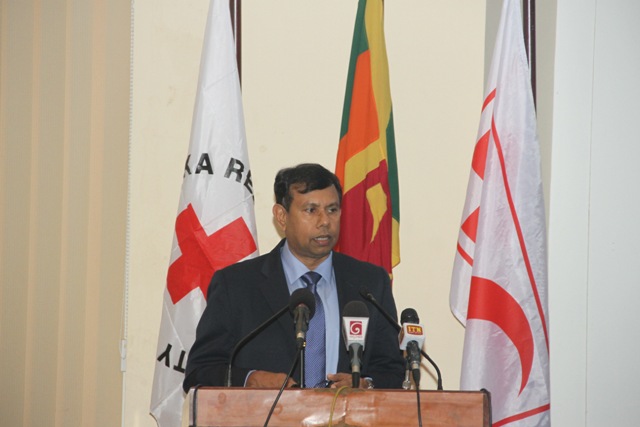Dr Ananda Mallawatantri delivers the Key Note Speech at the Launch of the “World Disasters Report 2016”
Published by the International Federation of Red Cross & Red Crescent Societies (IFRC), World Disasters Report 2016 - Resilience: saving lives today, investing for tomorrow was launched on 2 February 2017 at the Lakshman Kadiragamar Institute in Colombo.

Dr Ananda Mallawatantri delivering the Keynote speech.
Photo: SLRC
The report, an annual document which emphasizes the disasters that affect communities globally, stresses that a lack of global investment in strengthening community resilience and leaving tens of millions of people exposed to predictable, preventable and catastrophic disaster risks. It is interesting to note that the concluding chapter of this report; Resilience in the future: 2025 and beyond stresses the importance of “bouncing back” to “bouncing forward”.
Speaking at the launch, Director Sri Lanka Red Cross Society (SLRCS), General Neville Nanayakkara emphasized the role of the Red Cross in times of disasters. Also addressing the gathering was SLRCS Deputy Director, General Sudath Madugalle, who gave an overview of what the World Disasters Report comprises and what needed to be done for all key players. The Guest of Honour was Mr S. S. Miyanawala, Secretary to the Ministry of Disaster Management.
Delivering the keynote speech, Dr Ananda Mallawatantri, Country Representative of IUCN Sri Lanka outlined the two types of disasters; Natural and Man-made. He added that disasters have killed 1.35M people worldwide from 1996-2015, low and middle income countries account for 90% of fatalities and that the economic loss from 1980-2014 is US$ 3.3 trillion. The frequency of disasters have more than doubled during the last 35 years and most of the increase came from climate related events. Stressing the importance of disaster risk reduction, he said that only 0.4% of the 3.3 trillion US$ spent on aid was dedicated to disaster risk reduction. Presenting the IFRC’s definition on “Resilience”, Dr Mallawatantri briefed the gathering on seven drivers of resilience. Moving on to Sri Lanka context, he presented the distribution of damage and losses from 2000-2014 and area-vice number of persons affected by natural disasters from 2000-2016. Concluding the speech, Dr Mallawatantri stressed the importance of investing in resilience could be a priority with increased focus on Eco-DRR and climate change adaptation and said pre-disaster investment must be taken more seriously to reduce the increase in the number of crises.
A panel discussion was followed with the participation of Prof. Samantha Hettiarachchi - Professor of the Civil Engineering Department at the University of Moratuwa, Ms Gothami Chandraratne from the Disaster Management Department of SLRCS, Dr Vishaka Hidallage - Assistant Country Director of UNDP, Dr Ananda Mallawatantri - Country Representative of IUCN Sri Lanka, Ms Anoja Seniviratne - Director Planning and Research at the Ministry of Disaster Management.
